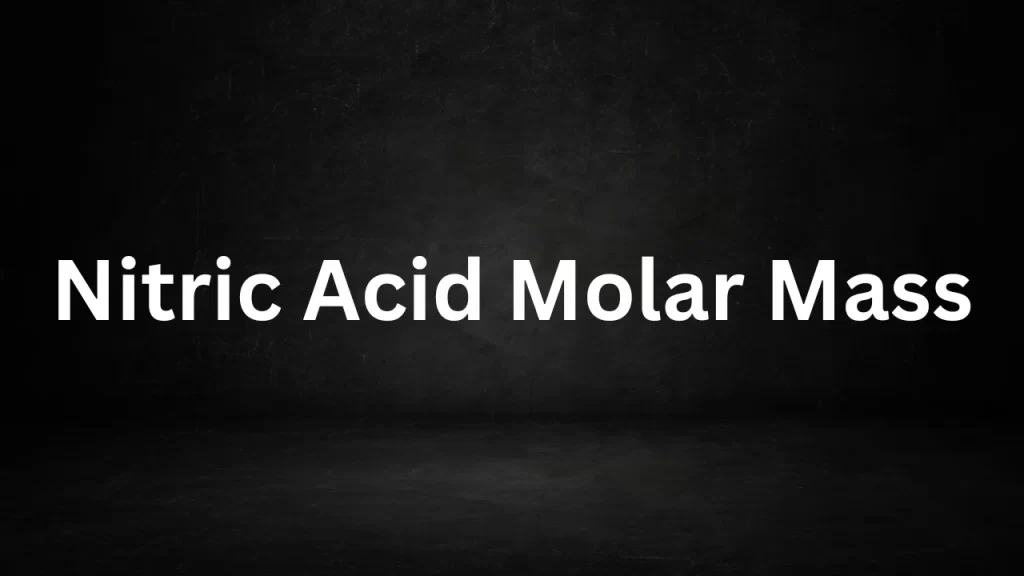Nitric Acid Molar Mass
Nitric Acid Molar Mass: Nitric acid (HNO3) is a powerful and versatile chemical with a wide range of applications in industry, chemistry, and even explosives manufacturing. In this article, we will explore the molar mass of nitric acid, its molecular structure, and its significance in various chemical processes.

Nitric Acid Molar Mass
The Importance of Nitric Acid
Nitric acid, sometimes simply referred to as “nitrate,” is a highly corrosive and strong acid. It is a crucial reagent in many chemical reactions, including the production of fertilizers, explosives, dyes, and various other chemicals. Additionally, it is used in the etching of metals, pickling of stainless steel, and in the manufacturing of nitrate salts, which have applications in food preservation.
Molecular Structure of Nitric Acid
Before delving into the molar mass of nitric acid, let’s understand its molecular structure. Nitric acid has a simple yet distinctive chemical formula: HNO3. This formula represents one hydrogen (H) atom, one nitrogen (N) atom, and three oxygen (O) atoms bonded together.
In its molecular structure, the nitrogen atom is bonded to one oxygen atom through a single bond and to another oxygen atom through a double bond. The third oxygen atom is connected to the nitrogen atom via a single bond and also bonded to one of the other oxygen atoms through a double bond. The presence of these double bonds and the arrangement of atoms give nitric acid its unique properties.
Molar Mass of Nitric Acid
The molar mass of a compound is defined as the mass of one mole of molecules of that compound, measured in grams per mole (g/mol). To calculate the molar mass of nitric acid (HNO3), we sum the atomic masses of its constituent atoms:
- Hydrogen (H) has an atomic mass of approximately 1.01 g/mol.
- Nitrogen (N) has an atomic mass of approximately 14.01 g/mol.
- Oxygen (O) has an atomic mass of approximately 16.00 g/mol.
Now, let’s calculate the molar mass of nitric acid:
Mol Mass of Nitric Acid (HNO3) = (1 × Atomic Mass of Hydrogen) + (1 × Atomic Mass of Nitrogen) + (3 × Atomic Mass of Oxygen)
Molar Mass of Nitric Acid (HNO3) ≈ (1 × 1.01 g/mol) + (1 × 14.01 g/mol) + (3 × 16.00 g/mol)
Molar Mass of Nitric Acid (HNO3) ≈ 63.03 g/mol
So, the molar mass of nitric acid is approximately 63.03 grams per mole.
Significance of Molar Mass in Chemistry
The mol mass of nitric acid is a crucial value in chemistry. It allows chemists to determine the quantity of nitric acid needed for specific chemical reactions and ensures precise measurements when handling this powerful acid. Whether it’s in the production of fertilizers to enhance crop growth or in the synthesis of explosives, a clear understanding of nitric acid’s molar mass is essential for safe and effective chemical processes.
Conclusion
The mol mass of nitric acid, approximately 63.03 g/mol, is a fundamental parameter in the world of chemistry. It underlines the importance of this potent acid in various industrial processes and scientific applications, emphasizing the need for careful handling and precise measurements to harness its powerful reactivity safely and effectively.
Read More
- Molar Mass of Helium
- Molecular Mass of CH3COOH
- Molecular Weight of kmno4
- Molecular Weight of CaCO3
- Molecular Mass Of CaCO3
Frequently Asked Questions (FAQs) Nitric Acid Molar Mass
Q1: What is the mol mass of nitric acid?
A1: The mol mass of nitric acid (HNO3) is approximately 63.03 grams per mole (g/mol).
Q2: Why is the mol mass of nitric acid important in chemistry?
A2: The mol mass of nitric acid is crucial because it allows chemists to relate the mass of nitric acid molecules to the number of molecules present in a sample. This value is fundamental for stoichiometry, chemical calculations, and the formulation of chemical reactions, especially when working with nitric acid in various industrial processes.
Q3: What are the main applications of nitric acid in industry and chemistry?
A3: Nitric acid is used in various applications, including:
- Fertilizer production: It’s a key component in the manufacturing of ammonium nitrate, a common nitrogen fertilizer.
- Explosives production: Nitric acid is used in the synthesis of explosives like nitroglycerin and TNT.
- Dye production: It’s used in the production of dyes and pigments.
- Metals processing: Nitric acid is employed in metal etching, cleaning, and pickling.
- Food preservation: In the form of nitrate salts, it’s used for curing and preserving meats.
Q4: Is nitric acid a strong acid?
A4: Yes, nitric acid is considered a strong acid. It readily donates a hydrogen ion (H+) in aqueous solution, making it highly acidic and capable of reacting vigorously with other substances.
Q5: Can nitric acid be dangerous to handle due to its strength and corrosiveness?
A5: Yes, nitric acid is highly corrosive and can be dangerous to handle. It can cause severe burns, and its fumes can be harmful if inhaled. Proper safety precautions, including the use of appropriate protective equipment and careful handling, are essential when working with nitric acid.